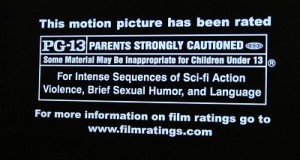
If you are like me, you’ve taken your eight-year-old child to a PG-13 movie. After reading all of the Harry Potter books, how could we not go see the movies? As a parent, that is my choice, but unfortunately, many movies are marketed to young children even though they carry the PG-13 rating. For example, a four-year-old child in my preschool has seen Transformers 2 even though it carries a PG-13 rating because he loves the toys. The Federal Trade Commission (FTC) has found for the seventh time that “movie studios intentionally market PG-13 movies to children under 13, and the movie industry does not have explicit standards in place to restrict this practice. The growing practice of releasing unrated DVDs undermines the rating system, and confuses parents.”
According to the Motion Picture Association of America:
A PG-13 rating is a sterner warning by the Rating Board to parents to determine whether their children under age 13 should view the motion picture, as some material might not be suited for them. A PG-13 motion picture may go beyond the PG rating in theme, violence, nudity, sensuality, language, adult activities or other elements, but does not reach the restricted R category. The theme of the motion picture by itself will not result in a rating greater than PG-13, although depictions of activities related to a mature theme may result in a restricted rating for the motion picture. Any drug use will initially require at least a PG-13 rating. More than brief nudity will require at least a PG-13 rating, but such nudity in a PG-13 rated motion picture generally will not be sexually oriented. There may be depictions of violence in a PG-13 movie, but generally not both realistic and extreme or persistent violence. A motion picture’s single use of one of the harsher sexually-derived words, though only as an expletive, initially requires at least a PG-13 rating. More than one such expletive requires an R rating, as must even one of those words used in a sexual context. The Rating Board nevertheless may rate such a motion picture PG-13 if, based on a special vote by a two-thirds majority, the Raters feel that most American parents would believe that a PG-13 rating is appropriate because of the context or manner in which the words are used or because the use of those words in the motion picture is inconspicuous.
Variety goes on to explain even PG movies “signal to parents that there may be some material not suitable for a child under 10.” These ratings are meaningless when it comes to marketing geared at young children. The FTC found in its seventh report on the subject:
As detailed in the marketing plans reviewed by the Commission, movie studios targeted violent PG-13 films to children under 13 both through advertising and promotional tie-ins with foods, toys, and other licensed products. Studios continued to place a significant number of ads for violent R-rated movies on television shows and Internet sites highly popular with children under 17. Increasingly, industry members post “red tag” trailers for R-rated movies, intended for age-restricted audiences, on the Internet without age-based access restrictions.
Ironically, the video game industry is leading the way at compliance with marketing and advertising rules. Video games are blamed more often than other forms of media for contributing to violent behavior in children.
The rating system has been compromised for years. The rating system is not in place for the same purpose that we think it is. Take for example the movie: Judge Dread. When the movie initially came out it had an X rating for violence. Watch this movie now and then flick on regular cable television, then ask yourself what rating this would receive now? I bet it would get a PG-13.
There is also an argument that if it is a PG-13 movie, why are you bringing a 7 year old to it in the first place? If you want a better idea on why movies are coming out these days without ratings watch: This Film is Not Yet Rated. However, I would not recommend letting your kids watch it.